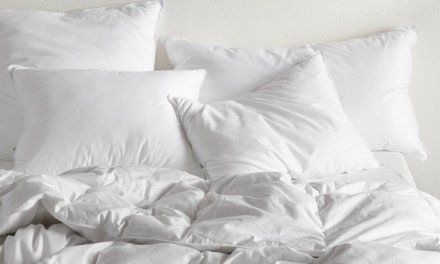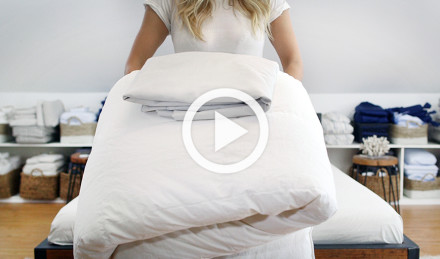When you imagine a bed, is it fluffy like a cloud? Then you’re likely envisioning down or down alternative bedding. But with a name like down alternative, is this just the lesser alternative? Hardly. These are two distinct options, and the right one for you depends on a number of factors.
Down is a natural fill made from the fluffy coating found beneath the feathers of waterfowl like geese and ducks. It functions in bedding the same as it does for the birds, by insulating for warmth.
Down alternative, on the other hand, is a hypoallergenic fill that mimics the fluffiness of down without the potential allergens, and it typically comes at a less expensive price.
But it can be tough to know exactly where to start when choosing between down vs down alternative as a bedding material. This guide will help you decide by giving you all the info you need — including the pros and cons of each — to help you make the best decision for the coziest, most comfortable night’s sleep.
What is Down?
What is Down?
When you snuggle into a fluffy pillow or cloud-like bedding, that’s typically thanks to down. Whether you’re choosing a down pillow, comforter or mattress topper, you can expect breathability and warmth from this natural material. Here’s what else you need to know about down.
Where Does Down Come From?
Down is the fluffy, soft layer found beneath the waterproof feathers on ducks and geese, which helps keep the birds warm even when paddling in cold water. You can immediately tell a down fill from a feather fill pillow because there aren’t any hard feather quill shafts sticking out of a down pillow. To ensure the supply comes from humanely treated ducks and geese, Parachute’s down is Responsible Down Standard certified.
Because down is a natural material that requires time and effort to collect and process, it’s typically a more expensive product. However, down has been used in bedding material for centuries for a reason, namely durability. So although the initial investment may be greater, down bedding can pay off in longevity.
Fill Power
Down expands naturally, which provides a number of benefits for down vs down alternative. As you might imagine, the expansion results in a fluffier, fuller looking product. Remember that cloud-like bed? That’s thanks to down’s fill power.
But fill power isn’t just for show. It’s a measurement of volume. Technically speaking, fill power is the number of cubic inches one ounce of the material fills.
Checking the fill power allows you to compare products objectively. Fill power is measured on a scale that typically increases by hundreds, with most down bedding products falling between 300 and 900. The higher the count, the more air the down can trap and the more warmth you’ll enjoy. Parachute bedding basics contain down with 750 fill power. You can learn more about fill power here.
If you’re in the market for a down comforter, fill power also indicates the product’s insulating ability. One of the best qualities of a down comforter is its ability to increase warmth without increasing the weight of the bedding.
Breathability
Because down expands, it allows the air to circulate, which makes down more breathable. So even though you may feel warm and cozy, you don’t feel hot and sweaty when sleeping on a down mattress topper or under a down comforter.
Unfortunately, the air pockets that give down its fluffy appearance can also trap allergens like dust mites and pollen. Encasing your down pillow or comforter in one of Parachute’s bedding protectors, with its tightly woven cotton fabric, can help reduce allergic irritation.
Pros and Cons
Here’s a quick overview of the pros and cons of down bedding.
Pros:
Down has a fluffy, full appearance but without extra weight.
The fill power number allows you to immediately know a product’s insulating properties that help keep you warm.
Durable material offers longevity.
Air circulation within the material helps prevent overheating while you sleep.
Cons:
Down products are generally more expensive.
The natural material can irritate those with allergies.
What is Down Alternative?
What is Down Alternative?
When comparing down vs. down alternative bedding, the latter is not necessarily the lesser material. Down alternative offers similar comfort as down, but its hypoallergenic fill allows allergy sufferers to snuggle in without wheezing. Down alternative is also typically the less expensive option.
How is Down Alternative Made?
Down alternative fill is crafted from fibers designed to mimic down and can include cotton, rayon, polyester and other synthetic material. Parachute’s down alternative products are made from 100% hypoallergenic microfiber fill, which allows its down alternative bedding products to be a cozy alternative to down.
However, because the synthetic material does not possess the same qualities as down, down alternative cannot achieve quite the same fluffiness. As a result, a down alternative blanket or comforter must be heavier to achieve the same warmth level.
Additionally, down alternative’s outer casing may also use natural and synthetic blends, so you can typically find a wider range of exterior fabrics for these products.
Allergens
One of the biggest selling points of down alternative bedding is that the fill is hypoallergenic, meaning the fill will not irritate allergy sufferers. And because down alternative bedding can be machine washed, you can clean the products more often to further reduce the opportunity for allergens and dust mites to collect.
Cost
For those on a budget, the price difference between down vs down alternative can be significant. Because it’s typically made with synthetic fibers, down alternative bedding can be produced more easily and thus can cost hundreds of dollars less than its down counterpart.
Pros and Cons
Check out this quick overview of the pros and cons of down alternative bedding.
Pros:
Down alternative’s hypoallergenic fill is a good alternative to down for severe allergy sufferers.
Bedding products are typically easier to care for.
It’s less expensive.
Cons:
More fill is required, so down alternative bedding must be heavier to provide warmth.
Synthetic material is less breathable, which may make down alternative bedding less comfortable for “hot sleepers.”
Down vs Down Alternative: How to Choose?
Now that you know what each bedding choice offers, how can you decide between down and down alternative products? We’ve broken down an easy way to compare based on five categories: comfort, allergen sensitivity, durability, care and price.
1. Comfort
Down vs Down Alternative: How to Choose?
Now that you know what each bedding choice offers, how can you decide between down and down alternative products? We’ve broken down an easy way to compare based on five categories: comfort, allergen sensitivity, durability, care and price.
1. Comfort
If you’re seeking the fluffiest pillow or the coziest comforter, down is likely your choice. The material’s ability to trap air naturally gives down fill bedding the more cloud-like feel and appearance.
Down’s breathability also allows better air movement to reduce overheating while you slumber. If you tend to sweat or “sleep hot,” down is the better choice.
Because of its ability to trap air, down bedding also requires less fiber material to offer warmth and fluffiness, which makes the bedding material lighter than down alternative.
2. Allergen Sensitivity
No matter how comfortable your bedding is, it’s useless if you’re up all night coughing and wheezing. When it comes to those with severe allergies, down alternative is your better choice.
Down’s natural material tends to attract dust and pollen in its air pockets, so it can irritate those with severe allergies.
The hypoallergenic fill of down alternative allows you to enjoy a similar experience of down without the potential irritants.
However, by encasing down bedding in a tightly woven protector, you can reduce the exposure to allergen irritants.
3. Durability
Down is a more durable material than down alternative’s synthetic fill, so down bedding will typically last longer.
In fact, down has been used for generations because of its longevity. When properly cared for, a down fill product can last for more than a decade.
4. Care
Down alternative bedding products can usually be washed at home, which makes them a convenient product in terms of care.
Down products require special care to help ensure their longevity and comfort. Typically dry cleaning is recommended.
However, regularly washing down alternative bedding may result in a breakdown of the fill material or outer shell more quickly.
Additionally, you can use a washable duvet cover to protect your comforter, thus reducing wear and tear from washing the comforter. Proper care will ensure both down and down alternative bedding lasts.
5. Price
Because down is a natural material, it costs more to source. Down alternative, with its synthetic fill, is typically the less expensive option.
Down vs Down Alternative Products
You’ll find a variety of down and down alternative bedding products at Parachute to fit your needs and style, including:
Duvet inserts/comforters
Pillows
Mattress toppers
Mattress pads
All of Parachute’s down bedding is made with luxurious European white down, known for its fluffiness and warmth (the color doesn’t really matter).
Whether you choose down or down alternative, you can protect your bedding with Parachute’s bedding protectors, which come in a wide variety of fabrics to meet your needs and style preferences.
Down vs Down Alternative Comforter
You can find the coziest comforters at Parachute, whether you choose down or down alternative.
Down comforters come in lightweight and all season varieties, which allows you to choose the best choice for where you live as well as the time of year.
Parachute’s lightweight down alternative comforter offers “hot sleepers” the benefits of down alternative bedding without the extra weight.
Down vs Down Alternative Products
You’ll find a variety of down and down alternative bedding products at Parachute to fit your needs and style, including:
Duvet inserts/comforters
Pillows
Mattress toppers
Mattress pads
All of Parachute’s down bedding is made with luxurious European white down, known for its fluffiness and warmth (the color doesn’t really matter).
Whether you choose down or down alternative, you can protect your bedding with Parachute’s bedding protectors, which come in a wide variety of fabrics to meet your needs and style preferences.
Down vs Down Alternative Comforter
You can find the coziest comforters at Parachute, whether you choose down or down alternative.
Down comforters come in lightweight and all season varieties, which allows you to choose the best choice for where you live as well as the time of year.
Parachute’s lightweight down alternative comforter offers “hot sleepers” the benefits of down alternative bedding without the extra weight.
Parachute comforters also feature a baffle box design. The loose quilting creates a grid pattern that ensures the filling stays evenly distributed while maintaining maximum loft.
Making Your Choice Between Down vs. Down Alternative
Armed with this information, you may feel ready to make your purchase — or you may be feeling a bit overwhelmed. No worries, Parachute has the expertise to help and offers free styling consultations that can guide you through the process of picking out the perfect pillows, duvets and covers. And you’ll find a wide array of fabric options for both down and down alternative bedding products.
Sweet dreams!
Making Your Choice Between Down vs. Down Alternative
Armed with this information, you may feel ready to make your purchase — or you may be feeling a bit overwhelmed. No worries, Parachute has the expertise to help and offers free styling consultations that can guide you through the process of picking out the perfect pillows, duvets and covers. And you’ll find a wide array of fabric options for both down and down alternative bedding products.
Sweet dreams!













